Find Employees and Keep Them With 9 Crucial Data Points
Here are nine questions to answer at critical touch points throughout the employee lifecycle to help your TA team find employees.

Some 4.35 million workers quit in February in a sign the U.S. labor market is still the tightest it’s been in decades. Employees have more leverage over employers and they are taking advantage of it, leaving for better jobs or more pay. Millions of Boomers used the pandemic as an excuse to retire and even before the pandemic, college enrollment had been declining. Talent shortages are at a ten-year high, with 69% of employers struggling to fill positions, up from just 14% in 2010. If you want to find employees, is the solution to hire more people as fast as possible to snap up the talent jumping ship?
Before you write the job description and assign recruiters to fill roles, take a step back to think strategically about your hiring needs. These nine tips are arranged to answer questions at critical touch points throughout the employee lifecycle from before the recruiter first calls until the employee finally moves on or retires.
1. Are we finding employees we need the most?

Visier can show you where applicants are in the pipeline for critical positions.
Finding employees to fill key positions is critical for all organizations. The recruiting team needs to ensure that these roles are filled quickly and that they receive the level of focus and resources required. Invariably, some of your employees will always move on. Does your organization have a formalized succession planning process to replace them? Using a people analytics solution makes it possible to see what your critical positions are, and look ahead to see when you’ll need to find employees for those positions. Access to and analysis of this data gives you the ability to craft an accurate hiring forecast. That way, you won’t find yourself struggling to find employees to fill a key role.
Read more: Ask Visier: Are the most critical positions in your organization being filled?
2. Which kinds of roles will need backfilling?
Do you know which employee groups will drive replacement needs in your company? If you have insights on who’s going to quit, and which groups are more prone to leave, you can get ahead of that curve. You’ll know where talent gaps exist in your organization, and you’ll be able to find employees to fill those gaps in your workforce. Identifying and addressing replacement talent makes it easier to attract top talent, avoid issues that may be on the horizon, and ensure you have the talent you need to meet business objectives.
Read more: Ask Visier: How Do You Find Out Which Employee Groups Will Drive Replacement Hiring Needs?
3. Are we spending too much on hiring?
How much are you spending on talent acquisition? Are your hiring resources being wasted? Do you have the right recruitment analytics tools to optimize talent acquisition? As with any process, optimization in talent acquisition is crucial. When you ensure the right number of quality candidates, hiring managers maximize their time interviewing qualified candidates. Narrowing down the list of potential candidates saves hiring resources. Anything greater than 5 qualified candidates per open role is typically a waste of the hiring manager’s time.
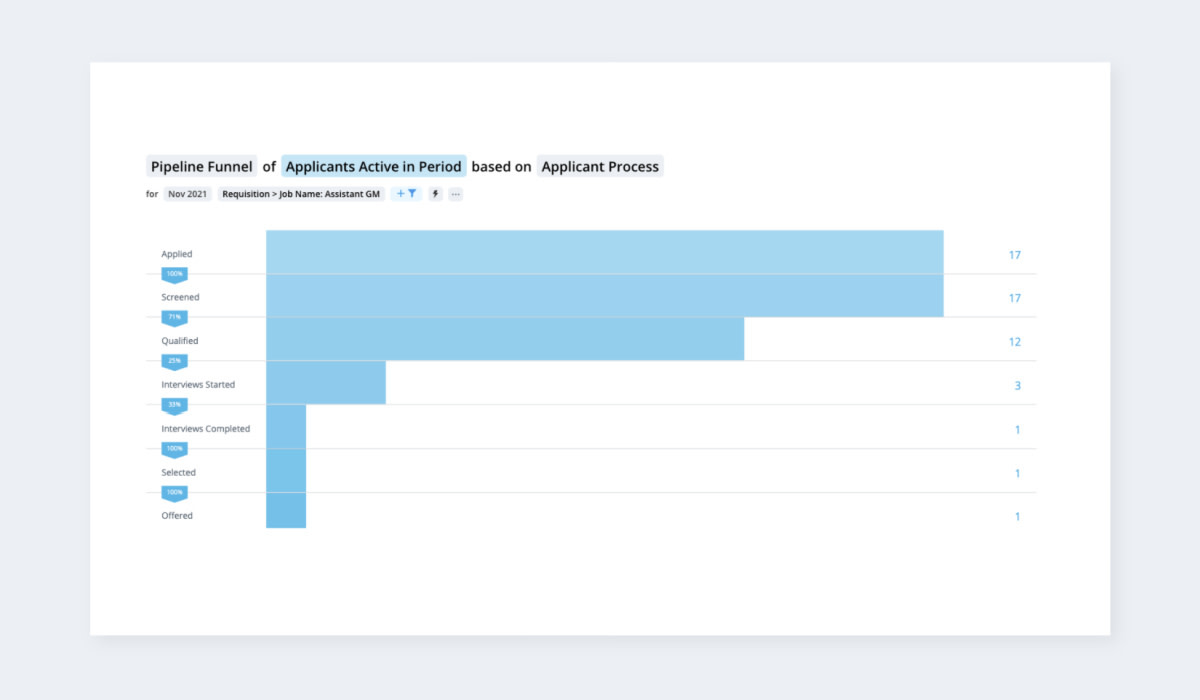
Visier shows how many applicants are active in the hiring pipeline, helping to show where you need to focus your hiring efforts.
Read more: Ask Visier: Are Your Hiring Resources Being Wasted?
4. Why aren’t we hiring as many diverse applicants?
One of the most important talent decisions we make that impacts diversity representation is who we hire. But hiring is a multi-layered process. Let’s say you found the perfect candidate, but they rejected the offer to become part of your team. Or perhaps you don’t know which hiring sources provide the candidates you need. If you are challenged with hiring diverse talent, it’s important to understand three main bottlenecks: if diverse candidates are applying for open positions, if these candidates are advancing through the hiring process, and if not, where they are dropping off and why.
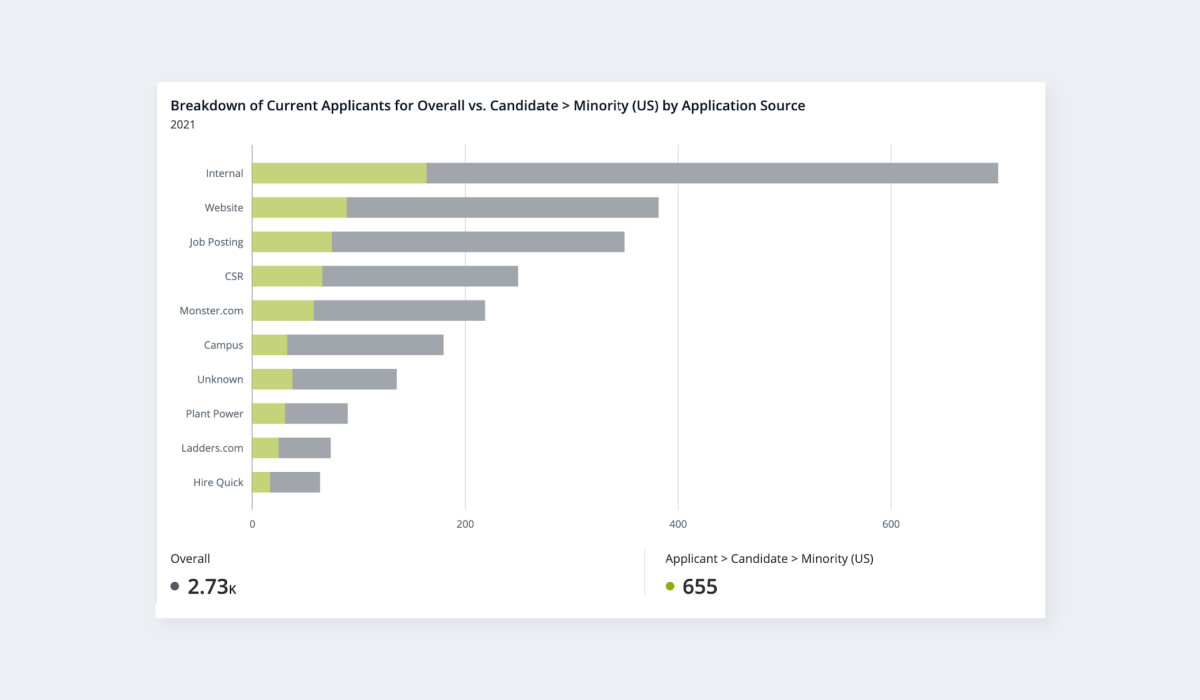
Visier demonstrates the ratio of diverse candidates to demonstrate patterns.
Read More: Ask Visier: Where are Diverse Applicants Abandoning the Recruiting Process?
5. How long does it take a new hire to get proficient?
Companies spend a lot of time and resources on onboarding. They pay hiring bonuses and invest heavily in the overall onboarding program. But for every role, no matter what skills employees come with, new hires have to ramp up to full productivity. Knowing the average time to productivity is a key part of knowing the true cost of replacing someone in your organization. And, it’s important to get an accurate measurement of a new hire’s skill to remove potential bias.
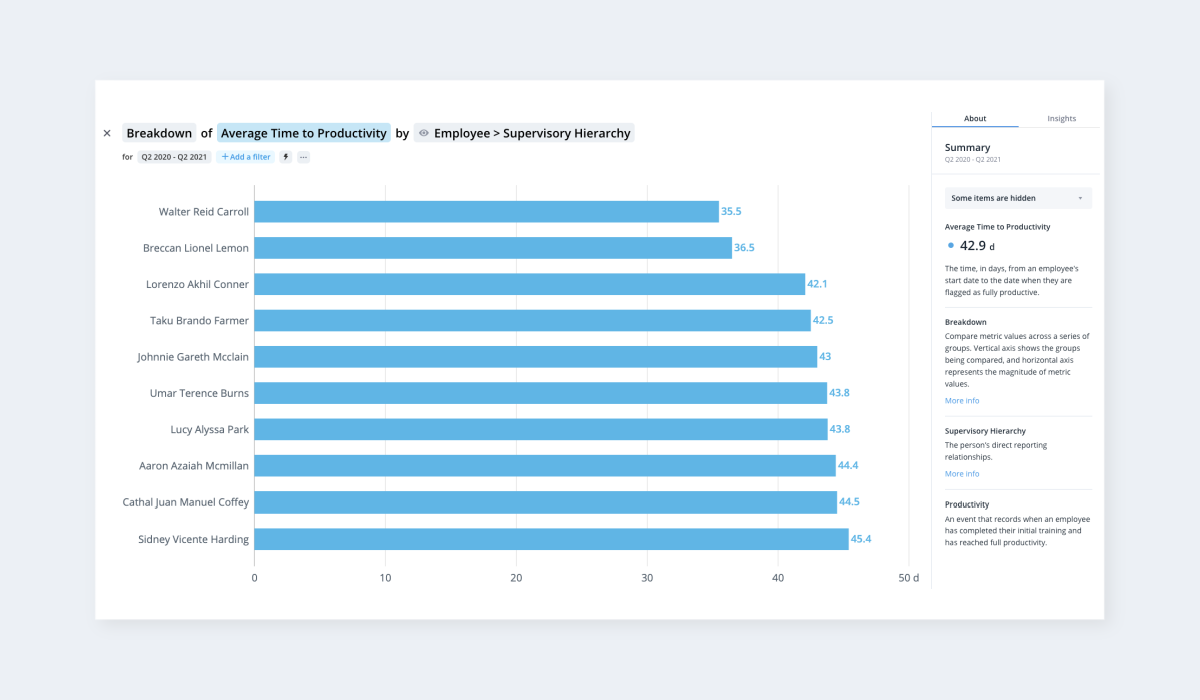
Visier can show not just average time to productivity, but can break it down into meaningful groups.
Read More: Ask Visier: What is the Average Time to Productivity?

Talent acquisition is on a whole new level in 2022. Get this guide to win with these creative strategies for attracting and hiring top talent.
6. Isn’t the paycheck all employees care about?
Employees expect more from employers than ever before, so a traditional view of pay as the only factor in employee compensation is too narrow, limited and won’t meet your employees’ needs. To address these broader workforce demands, consider adopting a more comprehensive view of pay beyond salary. A total package perspective changes the company’s focus from trying to get salary “right” to trying to get the total package right, or at least making the decision to focus on certain attributes and offerings at the expense of others. It’s important to design a meaningful total rewards program with appropriate employee compensation and benefits.
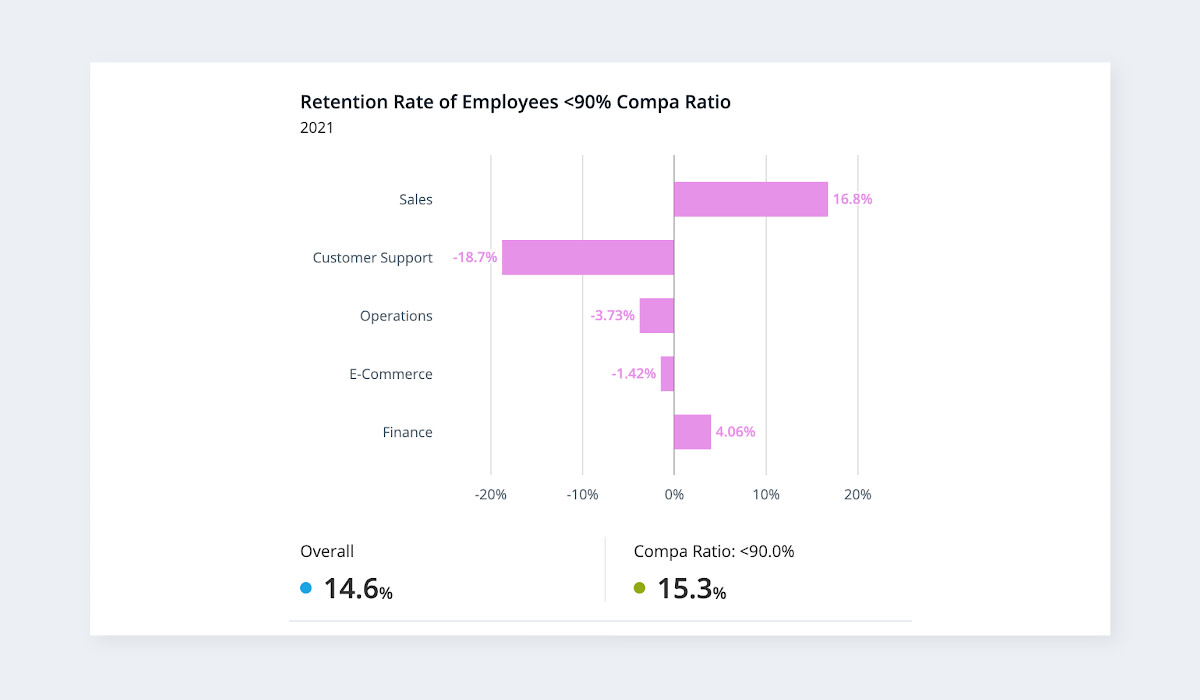
In this chart from Visier, the sample company shows pay has a strong effect on retention.
Read More: Ask Visier: How Can Total Rewards be Used More Effectively?
7. Are our salaries still competitive?
Even if your organization offers perfectly calibrated salaries to new hires, that doesn’t mean these won’t need to be adjusted some day. Over time, as hiring demands ebb and flow across different roles and departments within an organization, employee compensation ratios may begin to become unbalanced among teams, genders, levels, and geography. Trends of employee compensation, (especially pay) are more important in today’s market as employers continue to struggle to find and replace top talent.
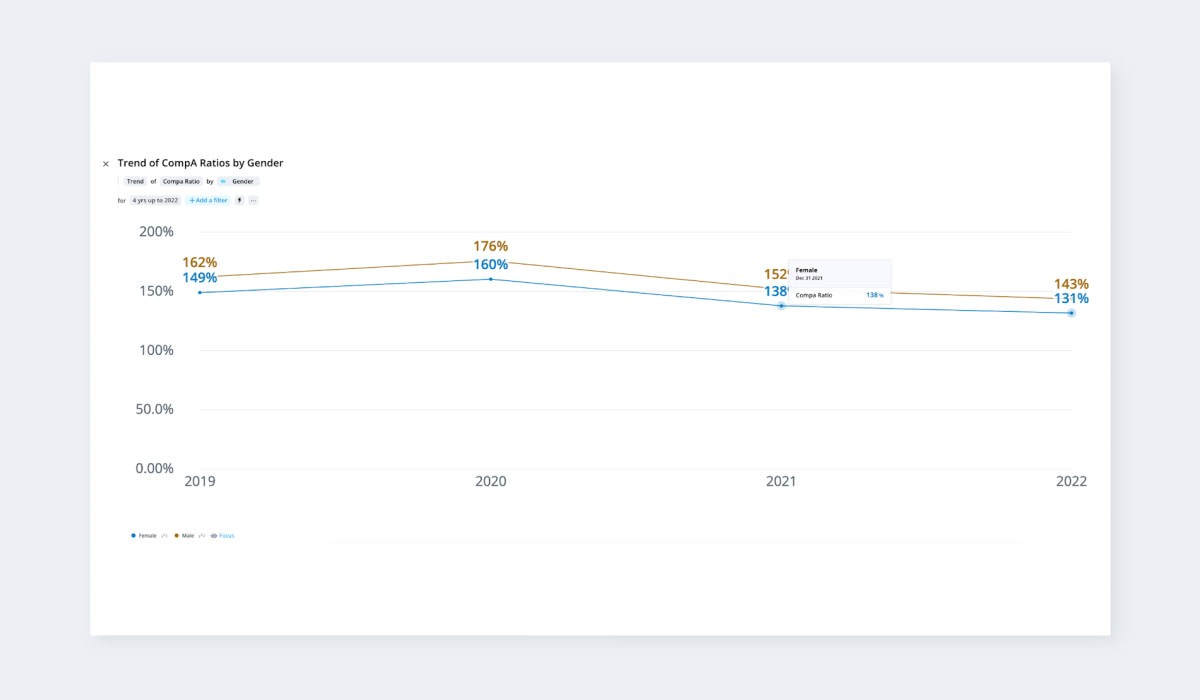
Visier can show not just compa ratios now, but how they’ve changed over time.
Read More: Ask Visier: How Has Employee Pay Changed Over Time?
8. Do we pay fairly based on gender, age, and race?
While there are laws in place to prohibit pay discrimination on the basis of gender, age, and race, many employers still struggle to achieve pay equity between groups. Compensation data is tightly guarded and often doesn’t get released to others in the company without C-suite approval. But if you don’t have information about how much every employee is earning, and access to data about the different demographics that make up your workforce, it’s nearly impossible to take action and ensure that consistent compensation policies are in place. You need to compare what different groups make in the same role, department, and years of experience, as well as factors, such as pay ranges for employees distributed across different locations.

Visier can break down average salary by ethnicity.
Read More: Ask Visier: How Do You Determine if Your Organization Pays Equitably?
9. How much does it cost to replace people who quit?
When an employee leaves your organization, you usually need to replace them, which can cost up to twice the employee’s salary. This number factors in the costs of interviewing and onboarding costs, and for some roles, the cost of overtime, contractors or agencies to pick up the work for the person who left while you search for their replacement. There may even be opportunity costs associated with employees that leave the organization. For example, sales that didn’t happen as a result of a vacancy or an important bit of information from a seasoned employee didn’t get shared with junior staff, which could have helped them efficiently complete a task. Lastly, don’t forget the indirect impacts of turnover, like a negative hit to company morale if high turnover rates are a new issue, or turnover contagion, which happens when people quit their jobs simply because other people are talking about leaving.
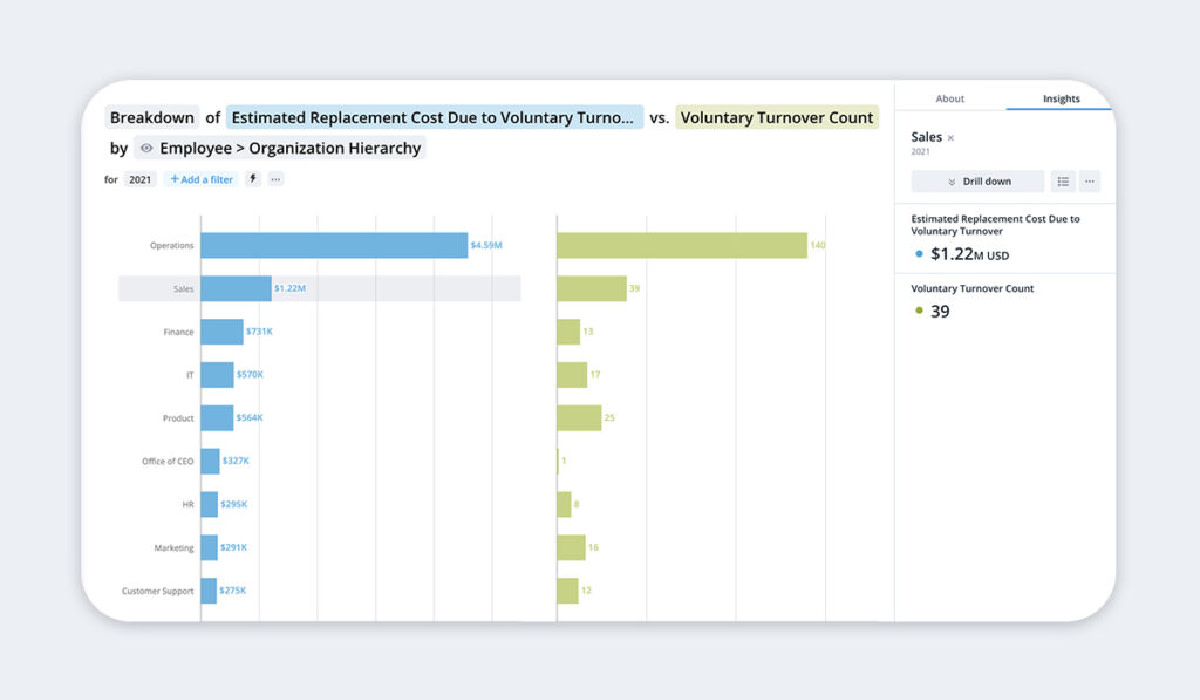
Visier can show you estimated costs of replacing an employee as well as metrics about who’s leaving and why.
Ask Visier: How Much Does it Cost to Replace an Employee?
People are the lifeblood of every company, and with so many people moving jobs or quitting the workforce altogether, it’s easy to make knee-jerk reactions. Take a step back to see the big picture and see how these rehiring needs fit into the broader context of what’s going on in your organization. Sound data analysis at every step of the journey will ensure you don’t just make good hires that truly fit your company’s needs, but that you keep your best people happy and productive.


